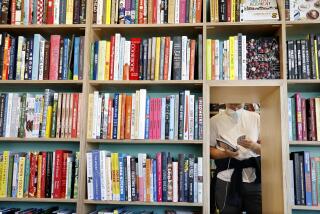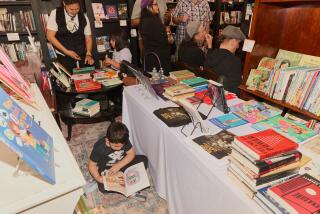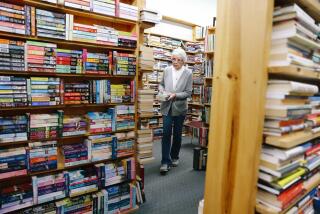Craftsman in Reseda Has Wisdom of the Ages Covered
David Weinstein likes to drop names as he leafs through books stacked in his cluttered backyard workshop in Reseda. But then these are no ordinary names.
Shakespeare, Einstein, Locke, among others.
As a hand bookbinder repairing centuries-old volumes, Weinstein, 24, frequently brushes up against the history he is trying to preserve.
He repaired the aging bindings on two of the first hand-printed books in English, published by William Caxton in the 1470s. They are valued at more than $100,000 per book, Weinstein says.
He built a conservation box for a letter penned by physicist Albert Einstein explaining his theory of relativity, which revolutionized scientific thought on planetary motion and gravitation.
He patched the deteriorating leather covering John Lockeâs personal copy of an âEssay Concerning Human Understanding,â a landmark treatise in Western philosophy written in 1690.
New Binding
He constructed a new binding and sewed in facsimile pages on two folios of William Shakespeareâs writings, collections drawn together in 1632 and 1684.
And now heâs fashioning a new binding for a Flemish version of the New Testament laboriously printed by monks in 1463. That work, which is owned by California State University, Northridge, will also feature ornate impressions stamped into the leather by hand.
âIâm in awe,â Weinstein said of the books under his care. âThereâs nothing so fantastic as to get a book considered important by scholars and have the authorâs own copy. Thereâs something magic about it.â
Weinstein is one of only 200 to 300 professional hand bookbinders in the United States, says the Guild of Book Workers, a national association of bookbinders, collectors and booksellers.
But even that estimate overstates the number of hand bookbinders who create archival-quality work on rare volumes, as does Weinstein, several bookbinders and collectors said.
Few Trusted With Task
âThere are only 10 to 15 binders I would trust to do our work,â said Norman Tanis, director of libraries at CSUN. âThere are some processes that can never be undone.â
Tanis said the Flemish New Testament will be designated the millionth volume in CSUNâs library collection. As such, it will be the centerpiece of a celebration marking the universityâs book-collecting efforts. CSUN expects to reach the million-volume mark in three or four years, he said.
Weinsteinâs âHeritage Bindery,â in a converted garage behind his house, is crammed with the tools of the trade--a guillotine used to slice precisely measured pages, shelves loaded with imported, tanned leather to be cut for covers, drawers stuffed with handmade and marbled paper and steaming pots filled with heated glue.
Then there are the racks of brass, hand-engraved tools for stamping leather-bound volumes with gold-leaf finishing. Many of the tools are 200 years old and most have a Victorian style, reflecting the predominance of English techniques of bookbinding.
And, of course, there are the books.
Language Barrier
Weinstein declares that he rarely has time to read the rare books that pass through his hands, and, given their age, language becomes a barrier too. âItâs kind of tough with Old English and when you donât know Latin,â he said.
Weinstein also collects books on, not surprisingly, bookbinding.
âI canât afford the books I work on,â he explains, noting that each is insured for up to $40,000 while in his shop.
Weinsteinâs fascination with âold stuffâ took root at 14 when he began handling volumes as a shipping clerk at his uncleâs Los Angeles store, the Heritage Book Shop. He then served as a volunteer bookbinder at the Huntington Library in San Marino, which stores one of worldâs foremost collections of rare books and manuscripts.
He pursued his trade under a master bookbinder in Bath, England, and at the London College of Printing. He said his year of course work in London was considered the equivalent of a seven-year apprenticeship.
Money From Accident
In October, 1982, Weinstein opened his shop in the backyard of a house he purchased in Reseda. The start-up money came from the legal settlement of a 1975 auto accident, which left Weinsteinâs pelvis shattered and required months of hospitalization. He said his pelvis still aches occasionally from his injuries.
But all that is forgotten when he talks about bookbinding. Looking somewhat haggard, the intense Weinstein speaks hurriedly, seemingly pressed for time.
âI used to think people thought this profession was dull, but Iâm beginning to realize how many people are turned on by it,â Weinstein said.
Weinstein employs three other bookbinders who split their time among their duties in the shop and the house and under the canvas tarp outside that shades such equipment as an electric wringer and two scything machines.
Income has doubled every year since he opened the shop, with revenue of more than $40,000 so far this year, he said. Thatâs good enough to open the next chapter in his bookbinding business.
Expansion Planned
In three months he plans to launch an expanded operation adjoining his uncleâs bookshop.
The shop may offer Weinstein new financial opportunities. It also has caused him to reevaluate his ambitions.
âOne side of me wants to go making lots of money by producing hundreds of pieces,â he said. âBut thereâs another side that just wants to make five or 10 pieces a week and have them be something someone would treasure.â
Gleaning bigger profits would require hiring more workers, each of whom would concentrate on one specialized task in the bookbinding process, such as hand sewing leaves of paper or parchment together, he said.
âThe book itself becomes just a cog when you have 20 people working on it, but duplicate items gain in uniformity.â
The satisfaction of mastering the entire process so far outweighs the lure of profit.
Weinsteinâs passion for bookbinding emerges as he explains his work. Books pile up haphazardly as he grabs for additional volumes that illustrate a particular technique of sewing pages or having covers embellished through dozens of hand stamping tools.
He calls himself a âtraditional bookbinderâ because he attempts to duplicate older styles rather than design new ones.
Weinsteinâs definition of a successful book restoration is creating one that finds anonymity on a shelf of books from the period.
He steers away from calling his work art because, he argues, highly stylistic and decorative bindings tend to upstage the book itself.
âI used to be offended by creative bookbinders in that their intention was to create a binding more powerful than the book,â he said.
âIâm looking for something that complements the book and doesnât compete. I bind books for people to read, books that are going to last for a lifetime and that people can treasure.â
Art Form
Still, he concedes an evolution toward the artistic side of bookbinding. âI once defended my right to be a craftsman. But Iâm beginning to understand it as an art form.â
A battery of distinct procedures, as many as 150, is required to replace a bookâs binding, he notes. The cost of a complete binding overhaul can vary from $300 into the thousands of dollars, and the time required can range from two days to several weeks.
Common repair jobs involve mending ripped pages or cleaning yellowed paper. For that, the answer is usually simple: water.
Over the years, sulfur dioxide in the air seeps into the paper, and, when touched by moisture, becomes sulfuric acid, making the pages brittle and yellowed.
âWater completely unwrinkles it and relaxes the pages. Itâs the ultimate cleaning process,â he says, unfolding a crumpled sheet from a bin of water.
Gold Leaf
One of the more ornate and delicate processes is the stamping of gold leaf into the leather covers.
âI kick everyone out of the shop for that. You canât reverse your work,â Weinstein says.
To pick up a sheet, Weinstein wipes a piece of cotton across his arm to collect oil from his skin. The oil provides the adhesion to gently lift the razor-thin sheet and lay it across the binding. The stamping tools, such as a decorative pallet, are heated on an electric gold-finishing stove. Next, they are pushed or rolled over the sheet, leaving a golden imprint on the book. Finally, the excess gold is removed.
Weinstein uses 23-carat gold leaf. But at widths of one-250,000th of an inch, each sheet is worth only 40 cents, he says.
Over two years, Weinstein says heâs collected four grams of excess gold, âjust enough to buy a six-pack.â
More to Read
Sign up for our Book Club newsletter
Get the latest news, events and more from the Los Angeles Times Book Club, and help us get L.A. reading and talking.
You may occasionally receive promotional content from the Los Angeles Times.








